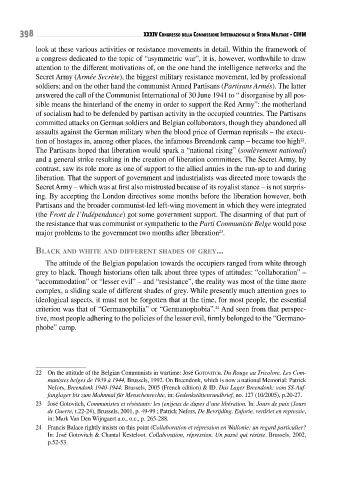Page 398 - Conflitti Militari e Popolazioni Civili - Tomo I
P. 398
398 XXXIV Congresso della CommIssIone InternazIonale dI storIa mIlItare • CIHm
look at these various activities or resistance movements in detail. Within the framework of
a congress dedicated to the topic of “asymmetric war”, it is, however, worthwhile to draw
attention to the different motivations of, on the one hand the intelligence networks and the
Secret Army (Armée Secrète), the biggest military resistance movement, led by professional
soldiers; and on the other hand the communist Armed Partisans (Partisans Armés). The latter
answered the call of the Communist International of 30 June 1941 to “ disorganise by all pos-
sible means the hinterland of the enemy in order to support the Red Army”: the motherland
of socialism had to be defended by partisan activity in the occupied countries. The Partisans
committed attacks on German soldiers and Belgian collaborators, though they abandoned all
assaults against the German military when the blood price of German reprisals – the execu-
tion of hostages in, among other places, the infamous Breendonk camp – became too high .
22
The Partisans hoped that liberation would spark a “national rising” (soulèvement national)
and a general strike resulting in the creation of liberation committees. The Secret Army, by
contrast, saw its role more as one of support to the allied armies in the run-up to and during
liberation. That the support of government and industrialists was directed more towards the
Secret Army – which was at first also mistrusted because of its royalist stance – is not surpris-
ing. By accepting the London directives some months before the liberation however, both
Partisans and the broader communist-led left-wing movement in which they were integrated
(the Front de l’Indépendance) got some government support. The disarming of that part of
the resistance that was communist or sympathetic to the Parti Communiste Belge would pose
major problems to the government two months after liberation .
23
black and white and different shades Of grey...
The attitude of the Belgian population towards the occupiers ranged from white through
grey to black. Though historians often talk about three types of attitudes: “collaboration” –
“accommodation” or “lesser evil” – and “resistance”, the reality was most of the time more
complex, a sliding scale of different shades of grey. While presently much attention goes to
ideological aspects, it must not be forgotten that at the time, for most people, the essential
criterion was that of “Germanophilia” or “Germanophobia”. And seen from that perspec-
24
tive, most people adhering to the policies of the lesser evil, firmly belonged to the “Germano-
phobe” camp.
22 On the attitude of the Belgian Communists in wartime: José gotoVitch. Du Rouge au Tricolore. Les Com-
munistes belges de 1939 à 1944, Brussels, 1992. On Breendonk, which is now a national Memorial: Patrick
Nefors, Breendonk 1940-1944, Brussels, 2005 (French edition) & ID. Das Lager Breendonk: vom SS-Auf-
fanglager bis zum Mahnmal für Menschenrechte, in: Gedenkstättenrundbrief, no. 127 (10/2005), p.20-27.
23 José Gotovitch, Communistes et résistants: les (en)jeux de dupes d’une libération. in: Jours de paix (Jours
de Guerre, t.22-24), Brussels, 2001, p. 49-99 ; Patrick Nefors, De Bevrijding. Euforie, verdriet en repressie,
in: Mark Van Den Wijngaert a.o., o.c., p. 265-288.
24 Francis Balace rightly insists on this point (Collaboration et répression en Wallonie: un regard particulier?
in: José Gotovitch & Chantal Kesteloot. Collaboration, répression. Un passé qui résiste. Brussels, 2002,
p.52-53.

